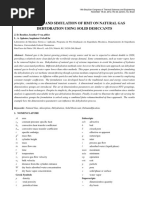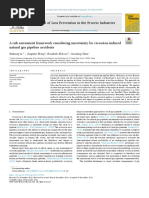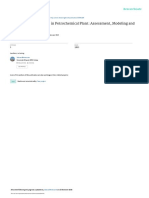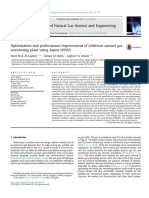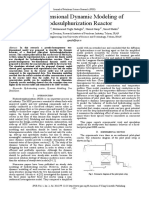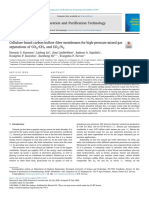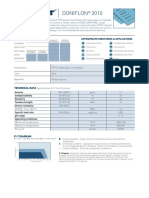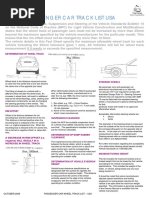Non-Destructive Testing of Drilling Oil and Gas Equipment and Tools
Non-Destructive Testing of Drilling Oil and Gas Equipment and Tools
Uploaded by
flasher_for_nokiaCopyright:
Available Formats
Non-Destructive Testing of Drilling Oil and Gas Equipment and Tools
Non-Destructive Testing of Drilling Oil and Gas Equipment and Tools
Uploaded by
flasher_for_nokiaOriginal Description:
Original Title
Copyright
Available Formats
Share this document
Did you find this document useful?
Is this content inappropriate?
Copyright:
Available Formats
Non-Destructive Testing of Drilling Oil and Gas Equipment and Tools
Non-Destructive Testing of Drilling Oil and Gas Equipment and Tools
Uploaded by
flasher_for_nokiaCopyright:
Available Formats
NON-DESTRUCTIVE TESTING OF DRILLING OIL AND GAS EQUIPMENT AND
TOOLS
Oleg Karpash, Petro Rajter
Ivano-Frankivsk National Technical University of Oil and Gas
Ukraine
Petro Krynychnyj
Research and Production Company ZOND
Ukraine
ABSTRACT
One of the most effective ways of preventing drill equipment (pipe strings) failures is the
evaluation of real technical state of threaded joints at various exploitation stages using
methods of non-destructive testing.
Detection of cracks in pipe body is reviewed. The parameters of inspection are
determined for various standard sizes of pipes.
Flaw detection in pipe threaded joints with triangular and tool-joints threads is discussed.
The ultrasonic method is proposed to use. The special techniques of non-destructive testing
are described. The most interesting is technique that allows flaw detection in heavy-weight
drill pipes threaded joint without disassembling. Also a novel technique for quality
inspection of thread stripping (bonding strength and leakproofness) is proposed. Threoretical
basis of this technique is discussed.
All techniques are impemented in real technical means that are showed and mentioned.
1
INTRODUCTION
The state-of-art of reservoir and oil-field development is accompanied by increasing set
of technical (high pressures and temperatures, corrosive mediums, deep wells etc.) and
ecological problems. All these factors cause the problem of safe failure-free operation of oil
and gas equipment.
Drilling equipment (especially pipe strings) failure analysis showed that the major part of
all failures (up to 50%) is caused by seal failures and loss of strength of threaded joints
(corrosion-fatigue destruction, deterioration, shear etc.). One of the most effective ways of
preventing such failures is the evaluation of real technical state of threaded joints at various
exploitation stages using methods of non-destructive testing.
A considerable experience in development of techniques and technical means for
defectoscopy of pipe threaded joints was accumulated in Ivano-Frankivsk National Technical
University of Oil and Gas and RPC ZOND over last 30 years.
Detection of flaws in pipe body
Inspection techniques that allow detection of flaws of different orientation in pipe body
will be reviewed below.
It is well known that the best condition for reliable flaw detection using ultrasonic
method is when ultrasonic waves fall at right angle on the defect plane. In fig. 1 the path of
ultrasonic wave (UW) in pipe wall is shown. The UW that is emmitted by piezoelectrical
transducer P with prism angle in point A with indicent angle goes through the pipe wall
with one reflection in point D normally to defect plane (point B), than goes back on the same
way to the transducer P.
Figure 1. Propagation of ultrasonic wave in pipe wall with defect
2
Where: inclination of defect plane, degrees; d pipe wall thickness, m; h defect
depth, m.
Now parameters of ultrasonic testing can be determined as following:
- UW incident angle:
= 90 (1)
- Piezoelectrical transducer prism angle:
= ) 90 sin( arcsin
2
1
l
l
C
C
(2)
- Distance between UW incident point and defect:
sin
cos 2 h d
L
= . (3)
Where: C
l1
and C
l2
accordingly longitudinal and transversal ultrasonic waves
propagation velocities.
But there can be such conditions when UW falls on defect plane at not quite right
angle. The example of ultrasonic wave propagation at this case is shown on fig. 2.
Figure 2. . Propagation of ultrasonic wave in pipe wall with defect oriented at the angle to
wave path
3
Parameters of ultrasonic inspection now can be determined using following equations:
- UW incident angle:
) ( 90
1
= (4)
- UW receiving angle:
) ( 90
2
+ = (5)
- emmitting piezoelectrical transducer prism angle:
+ = ) cos( arcsin
2
1
1
l
l
C
C
(6)
- receiving piezoelectrcial transducer prism angle:
= ) cos( arcsin
2
1
2
l
l
C
C
(7)
- distance between receiving transducer and the defect:
) (
2
) sin(
cos
=
ctg
d h
L (8)
- distance between emmitting and receiving transducers:
) cos(
cos
) (
1
) (
2
) (
5
+
+
+
+
+
= h
tg ctg ctg
d
l (9)
where: UW incident angle on defect plane, degrees.
According to [1] pipes with defects in body with depth more than 3 mm need to be
screened. Authors experimentally established [2] that inclination of fatigue defect plane is
near 22. Now if we define h = 3 mm, = 22 using equations (4)-(8) we can determine the
parameters of ultrasonic inspection of drill pipe bodies for detection flaws of transversal
orientation Table 1.
4
Table 1. Parameters of ultrasonic inspection of drill pipe bodies
Pipe
standard
diameter,
mm
Wall
thickness, mm
UW incident
angle ,
degree
Transducer
prism angle ,
degree
Distacnce between
UW incident angle
and defect L, mm
7 72.6
60
9
79 55.5
93.2
7 72.6
9 93.2 89
11
79 55.5
113.8
9 93.2
114
10
79 55.5
103.5
9 93.2
127
11
79 55.5
113.8
9 93.2
140
11
79 55.5
113.8
Flaw detection in pipe threaded joints with triangular thread
Pipes with triangular thread are widely used in oil and gas industry [GOST 631-75, API
Spec 5B].
For detection of corrosion-fatigue cracks in threaded joints at early stage of cracking an
ultrasonic method was proposed. This method enables flaw detection in threaded pipe joints
when pipes are being made-up (with inner barrel lock or with tool joint box).
To establish regularities of ultrasonic wave propagation in threaded joints of different design
theoretical and experimental investigations were carried out. It was shown that ultrasonic waves
propagation in tapered thread needs to be viewed considering its reflection ability from thread
profile which form a set of artificial reflectors with sizes (2.54 mm) that are bigger than fatigue
cracks (1-1.5 mm) at the early stage of cracking. Fatigue crack front orientation was
experimentally determined for cracks that propagate in thread vee. Effective defectoscopy
techniques (Fig. 3) were developed, optimal inspection parameters were established as well as
technical means (piezoelectric transducers and scanners) were designed (Fig.4). Using these
techniques together with specialized technical means allow to detect flaws in threaded joints
during round-trip directly at the drilling rigs.
5
1 outgoing pulse; 2 pulse from butt-end; 3 pulse from flaw in 5
th
thread vee; 4 pulse from
flaw in 1
st
thread vee; 5 - gate; 6 artificial flaw
Figure 3. Scheme of flaw detection in triangular pipe threaded joints and flaw detector screen
view
Figure 4. Special scanner and piezoelectric transducer for defectoscopy of threaded joints
6
Defectoscopy of pipe threaded joints with tool-joint thread
A considerable part of oil and gas pipe grades are connected using tool-joint thread
[GOST 5286, API Spec 5B]. These are heavy-weight drill pipes (HWDP) and pipes with
enhanced strength and impermeability.
Nowadays approaches for defectoscopy of threaded HWDP joints are not effective
because of bigger wall thickness (up to 50 mm) and consequently bigger depth of defect
occurrence.
A common defectoscopy technique that is used for threaded joints of HWDP foresees
inspection from end surface of threaded joint. This technique requires pipes to be dissambled
and this result in poor efficiency and danger for personnel during round-trip.
We proposed the method of flaw-detection of HWDP threaded joint in assembled state.
The method can be realized using two split-type piezoelectric transducers oriented in a
special manner and installed on the outer surface of tool-joint pin. At the same time acoustic
axes of transducers should lay in one plane which should be parallel with longitudinal pipe
axis and they should intersect at the plane of flaw (Fig. 5). This condition can be reached only
with correct ultrasonic wave incident angles and distance between incident points. These two
parameters depend on thread joint standard size.
For good flaw detection throughout threaded joint generatrix the system for synchronous
scanning along helical line with step equal to thread pitch was developed.
View A
1 - flaw; 2 inspected pipe;
3,4 emitting and receiving transducer accordingly
Figure 5. Inspection of tool-joint threads using two transducers
The results of the researches described above were implemented in mobile flaw-
detection systems (PLNK-2 and PLNK-5). These systems enable inspection of threaded joints
of drilling pipes at drilling rigs, pipe yards and repair depots.
7
Quality inspection of thread stripping (bonding strength and leakproofness)
Over the past 20 years heavy industry has been producing drill pipes with threaded joints
of enhanced strength and leakproofness (types Buttress, Valurek, VAM etc.). But usage of
these pipes for first several years resulted in raising number of failures. The new problem to
solve was to determine the failure reasons and develop the corresponding methods for quality
inspection. In fact the major part of all breakdowns was caused by seal failure and strength
loss in threaded joints. The main reasons of threaded joints failures are the following:
- abuse of pipe strings
- breakdowns during making-up of joints
- imperfect design of pipes
- absence of technical means for quality inspection of threaded joints during operational
process.
We pioneered and implemented new approach for quality rating of threaded joints of
drilling equipment at different stages of their operational period. This approach consists not
only in flaw detection in metal (including corrosion-fatigue cracks) but also in measuring the
parameters which determine strength and leakproofness of threaded joint. Traditional
methods for threaded joints quality control are based on measurement of indirect parameters
(relative tension, torque strength, number of screwable elements turns etc.) and they dont
allow evaluating the actual technical state of joint after making-up and after some period of
operating. After the investigations it was determined that the following characteristics should
be considered as new informational ones:
during making-up process : point of time when the tension in the most loaded elements
of a threaded joint is near yield stress of the material; after making-up and during operational
process: magnitude of actual contact area and level of radial deformations in connected
elements.
The efficiency of the use of ultrasonic method of non-destructive testing for measuring
parameters that determine threaded joint quality was proved. Theoretical and experimental
studies of correlation between operating characteristics of threaded joint and acoustic
parameters were done.
The most effective is technique which enables multiple reflection of ultrasonic wave from
surface of contact. The use of this technique allows the determination of average and minimal
values of tension without scanning the outer surface of joint what result in higher production
rate and reliability of inspection. Figures 6 and 7 show the technique implementation.
The main point of the technique is that ultrasonic wave hade on the inner surface of the
external member should be determined from equation (10):
]
6
sin
12
sin 4 1 [
6
sin
2
n n
R r R
n
R
arctg
= (10)
where: R, r accordingly radiuses of outer surfaces of external and internal members, m; n
quantity of reflections from inner surface of external member in sector with chord equal to R.
8
) b)
Figure 6. Technique for diametrical tension inspection using ultrasonic method (a) and image
on defectoscope screen during inspection (b)
Figure 7. Special scanner for quality inspection of made-up threaded joints
CONCLUSIONS
Developed techniques and methods were applied in oil and gas industry of Ukraine by
Research and Production Company ZOND for last 12 years. The main technical means that
implement the described methods are specialized transducers, scanners of different design,
portable and mobile non-destructive systems PLNK-2 and PLNK-5. More details about the
innovative technologies developed in RPC ZOND available on http://www.zond-ndt.com.
9
REFERENCES CITED
(1) RD-39-013-90 Precept for drill pipes operation. Kujbyshev: VNIITneft. 1990.
228 p. (in russian).
(2) Karpash O., Krynychnyj P. and others. Non-destructive testing of drill pipe grades.
Ivano-Frankivsk:Fakel, 2001.- 380 p. (in ukrainian).
ACKNOWLEDGMENTS
The authors wish to acknowledge Scientific and Research Institute of Oil and Gas
Technologies, Ivano-Frankivsk (Ukraine) for financial support of this work.
10
You might also like
- Waste Tire Pyrolysis Using Thermal Solar Energy - An Integrated ApproachDocument8 pagesWaste Tire Pyrolysis Using Thermal Solar Energy - An Integrated ApproachJosé Miguel GonzálezNo ratings yet
- Heavy Oil Recovery Using Hydrogen PeroxideDocument1 pageHeavy Oil Recovery Using Hydrogen PeroxideDivyam SoodNo ratings yet
- Comparative Environmental Life Cycle Assessment and Operating Cost Analysis of Long Range Hydrogen and Biofuel Fueled Transport AircraftDocument26 pagesComparative Environmental Life Cycle Assessment and Operating Cost Analysis of Long Range Hydrogen and Biofuel Fueled Transport AircraftIdris EpNo ratings yet
- Modeling and Simulation of HMT On Natural Gas Dehydration Using Solid DesiccantsDocument8 pagesModeling and Simulation of HMT On Natural Gas Dehydration Using Solid DesiccantsGEORGEVPAUL_14565666No ratings yet
- Thermal Recovery Technology For Heavy Oil: Science & Technology Management DepartmentDocument29 pagesThermal Recovery Technology For Heavy Oil: Science & Technology Management DepartmentRavi SeedathNo ratings yet
- Model Predictive Control Strategies Perf PDFDocument12 pagesModel Predictive Control Strategies Perf PDFDodi RachmanNo ratings yet
- Mathematical Modeling of Process Liquid Flow Acetoclastic Methanogenesis Under Mesopilic Conditions in Two Phase Biogas ReactorDocument9 pagesMathematical Modeling of Process Liquid Flow Acetoclastic Methanogenesis Under Mesopilic Conditions in Two Phase Biogas ReactorDoron MbenxNo ratings yet
- Scaling-Up Vegetable HDT Reactor ModelsDocument8 pagesScaling-Up Vegetable HDT Reactor ModelsJorge AncheytaNo ratings yet
- A Risk Assessment Framework Considering Uncertainty For Corrosion-Induced Natural Gas Pipeline AccidentsDocument11 pagesA Risk Assessment Framework Considering Uncertainty For Corrosion-Induced Natural Gas Pipeline AccidentsMuhammad Nur FauziNo ratings yet
- 3 s2.0 B9780323511339000073 MainDocument11 pages3 s2.0 B9780323511339000073 MainMuhammad AdeelNo ratings yet
- Models Methods Simulating Gas Pipeline Blowdown (1989) - KK Botros Et AlDocument11 pagesModels Methods Simulating Gas Pipeline Blowdown (1989) - KK Botros Et AlbeenolandNo ratings yet
- 1 s2.0 S0255270118302502 MainDocument22 pages1 s2.0 S0255270118302502 MainopicitisNo ratings yet
- Bioremediation of Petroleum Hydrocarbon-Contaminated Soil byDocument10 pagesBioremediation of Petroleum Hydrocarbon-Contaminated Soil byAlis PastranaNo ratings yet
- Optimization of Biodiesel Production From Castor Oil by Taguchi DesignDocument12 pagesOptimization of Biodiesel Production From Castor Oil by Taguchi Designjuan estebanNo ratings yet
- Techno-Economic Comparison of 100% Renewable Urea Production ProcessesDocument15 pagesTechno-Economic Comparison of 100% Renewable Urea Production ProcessesNestor TamayoNo ratings yet
- MeroxDocument3 pagesMeroxJay LawsonNo ratings yet
- Spe 138918 MSDocument6 pagesSpe 138918 MSNavneet SinghNo ratings yet
- Modelling of The Cathodic Protection System With Dynamic Non-Linear Polarization CharacteristicsDocument5 pagesModelling of The Cathodic Protection System With Dynamic Non-Linear Polarization CharacteristicsRizky RNo ratings yet
- Well 1 AssumptionsDocument19 pagesWell 1 AssumptionsDaryat RiwalinoNo ratings yet
- ErosionDocument14 pagesErosionidrissimedsalah1No ratings yet
- Separator GazeDocument4 pagesSeparator Gazestef11_127571No ratings yet
- Fire ExplosionDocument15 pagesFire ExplosionMutiaraNo ratings yet
- BIo Jet Furfural México PDFDocument23 pagesBIo Jet Furfural México PDFEstefania Ortiz AriasNo ratings yet
- Algal Research: Eduardo Cano-Pleite, Mariano Rubio-Rubio, Néstor García-Hernando, Antonio Soria-Verdugo TDocument11 pagesAlgal Research: Eduardo Cano-Pleite, Mariano Rubio-Rubio, Néstor García-Hernando, Antonio Soria-Verdugo TAdi permadiNo ratings yet
- Abb El 3060Document20 pagesAbb El 3060రామకృష్ణ పాశలNo ratings yet
- Hazop Finals ExcelDocument36 pagesHazop Finals ExcelHandyNo ratings yet
- Sulphur 1Document15 pagesSulphur 1vissusamuraiNo ratings yet
- c1Document45 pagesc1Sig BahaNo ratings yet
- OSHA Technical Manual PDFDocument102 pagesOSHA Technical Manual PDFAshish PatelNo ratings yet
- White Paper On Liquid Hydrocarbon Drop Out in Natural Gas InfrastructureDocument30 pagesWhite Paper On Liquid Hydrocarbon Drop Out in Natural Gas InfrastructureHans MuellerNo ratings yet
- Wear in PipesDocument19 pagesWear in Pipesabhishek-ram1703No ratings yet
- Riopipeline2011 Ibp1525 11Document10 pagesRiopipeline2011 Ibp1525 11dmlsfmmNo ratings yet
- Cara ConvertDocument8 pagesCara ConvertBarbara_LFCNo ratings yet
- Medidores Rotativos Série FMRDocument3 pagesMedidores Rotativos Série FMRmateuNo ratings yet
- Vulnerability Assessment of Buried Pipelines: A Case StudyDocument10 pagesVulnerability Assessment of Buried Pipelines: A Case StudySEP-PublisherNo ratings yet
- Application of Evolutionary Computational Approach in Design of Horizontal Three-Phase Gravity SeparatorsDocument8 pagesApplication of Evolutionary Computational Approach in Design of Horizontal Three-Phase Gravity Separatorsagnotts2009No ratings yet
- Inventory Renewable Energy StandardsDocument41 pagesInventory Renewable Energy Standardskolombo1776No ratings yet
- Petroleum Decline AnalysisDocument3 pagesPetroleum Decline AnalysisBhuvanesh MathesanNo ratings yet
- An Analysis and Prediction of Hydrocarbon Dew Points and PDFDocument19 pagesAn Analysis and Prediction of Hydrocarbon Dew Points and PDFAníbal MellanoNo ratings yet
- Capital Cost Scaling MethodologyDocument45 pagesCapital Cost Scaling MethodologyManish ParetaNo ratings yet
- SPE Paper - Cross Hair Scatter PlotsDocument8 pagesSPE Paper - Cross Hair Scatter PlotsLuis Alberto Colan GarciaNo ratings yet
- Boiling Range of GasolineDocument4 pagesBoiling Range of GasolineSaad AhmedNo ratings yet
- Hydraulic Fracturing Research PaperDocument9 pagesHydraulic Fracturing Research PaperNathanNo ratings yet
- Theoretical and Observational Assessments of Flare EfficienciesDocument7 pagesTheoretical and Observational Assessments of Flare EfficienciesArcangelo Di TanoNo ratings yet
- Mdf-10-Exp 60Document2 pagesMdf-10-Exp 60omar vargasNo ratings yet
- Design and Evaluation of Acid Fracturing Treatments: by Kamel Ben-Naceur and Michael EconomidesDocument10 pagesDesign and Evaluation of Acid Fracturing Treatments: by Kamel Ben-Naceur and Michael Economidesswaala4realNo ratings yet
- 30408-12 - Manual PDFDocument2 pages30408-12 - Manual PDFmarceloestimuloNo ratings yet
- Elastopipe A Flexible Piping System Trelleborg Offshore PDFDocument2 pagesElastopipe A Flexible Piping System Trelleborg Offshore PDFprasad336100% (1)
- A New Equation of State For Carbon DioxideDocument89 pagesA New Equation of State For Carbon Dioxideaegean227No ratings yet
- HDS Reactor ModelDocument4 pagesHDS Reactor Modelpcyadav8No ratings yet
- Technical Presentation On Condensate ClassificationDocument23 pagesTechnical Presentation On Condensate ClassificationRaboni ZitelinaNo ratings yet
- Chebotarev 1955 Metamorphism of Natural Waters 2Document34 pagesChebotarev 1955 Metamorphism of Natural Waters 2Trevor FranklinNo ratings yet
- Industrial Risk Assessment Using ALOHADocument16 pagesIndustrial Risk Assessment Using ALOHAadwitiya1No ratings yet
- SPE-10127 Bashbush J.L. A Method To Determine K-Values From Laboratory Data and Its ApplicationsDocument16 pagesSPE-10127 Bashbush J.L. A Method To Determine K-Values From Laboratory Data and Its Applicationsjohndo3No ratings yet
- Cellulose-Based Carbon Hollow Fiber Membranes For High-Pressure Mixed Gas Separations of CO2 - CH4 and CO2 - N2Document11 pagesCellulose-Based Carbon Hollow Fiber Membranes For High-Pressure Mixed Gas Separations of CO2 - CH4 and CO2 - N2Phatchayada KhamhaengNo ratings yet
- Pexgol - Instructions For InstallationDocument4 pagesPexgol - Instructions For InstallationFlorin StanciuNo ratings yet
- Spe 173867 MsDocument11 pagesSpe 173867 Msfangzhou xuNo ratings yet
- Ultrasonic Guided Waves Evaluation of Trials For Pipeline InspectionDocument9 pagesUltrasonic Guided Waves Evaluation of Trials For Pipeline InspectionEmily BrockNo ratings yet
- Automatic Inspection of Welded Pipes With Ultrasound: ECNDT 2006 - Tu.2.3.1Document14 pagesAutomatic Inspection of Welded Pipes With Ultrasound: ECNDT 2006 - Tu.2.3.1Jeremy BeltranNo ratings yet
- Measurement While Drilling: Signal Analysis, Optimization and DesignFrom EverandMeasurement While Drilling: Signal Analysis, Optimization and DesignNo ratings yet
- LC1D115P7: Product Data SheetDocument3 pagesLC1D115P7: Product Data Sheetflasher_for_nokiaNo ratings yet
- Data Sheet P 550: Technical InformationDocument1 pageData Sheet P 550: Technical Informationflasher_for_nokiaNo ratings yet
- HDLS Series Switches: Installation Instructions For TheDocument4 pagesHDLS Series Switches: Installation Instructions For Theflasher_for_nokiaNo ratings yet
- Sample Only: Api 6A, Api Q1Document6 pagesSample Only: Api 6A, Api Q1flasher_for_nokiaNo ratings yet
- Assessing Rock Compressive Strength and Predicting Formation Drillability Using Sonic, Gamma & Density LogsDocument7 pagesAssessing Rock Compressive Strength and Predicting Formation Drillability Using Sonic, Gamma & Density Logsflasher_for_nokiaNo ratings yet
- Thermowell For Thermometers ManualDocument40 pagesThermowell For Thermometers Manualflasher_for_nokia100% (1)
- Parts Manual For F1600 1300Document23 pagesParts Manual For F1600 1300flasher_for_nokiaNo ratings yet
- Doniflon 2010: Properties Appropriate Industries & ApplicationsDocument2 pagesDoniflon 2010: Properties Appropriate Industries & Applicationsflasher_for_nokiaNo ratings yet
- rfb7 de en PDFDocument2 pagesrfb7 de en PDFflasher_for_nokia100% (1)
- Twelve Point Flange Screws: Earnest Technical BulletinDocument1 pageTwelve Point Flange Screws: Earnest Technical Bulletinflasher_for_nokiaNo ratings yet
- Mabanol Xenon Alpha Synth 5W-40: Synthetic High Performance Engine OilDocument1 pageMabanol Xenon Alpha Synth 5W-40: Synthetic High Performance Engine Oilflasher_for_nokiaNo ratings yet
- Duraflo Composite Oemduea Mongoose PsDocument2 pagesDuraflo Composite Oemduea Mongoose Psflasher_for_nokiaNo ratings yet
- Mud Pump Consumables - enDocument24 pagesMud Pump Consumables - enflasher_for_nokia100% (1)
- HpuDocument1 pageHpuflasher_for_nokiaNo ratings yet
- Wheel Track Suspension List USADocument29 pagesWheel Track Suspension List USAflasher_for_nokiaNo ratings yet
- Chapter 3BDocument1 pageChapter 3Bflasher_for_nokiaNo ratings yet
- Mabanol Xenon Alpha Synth 5W-40 EDocument12 pagesMabanol Xenon Alpha Synth 5W-40 Eflasher_for_nokiaNo ratings yet
- Journal of Materials Processing Technology: Chen Hua, Hao Lu, Chun Yu, Jun-Mei Chen, Xiao Wei, Ji-Jin XuDocument11 pagesJournal of Materials Processing Technology: Chen Hua, Hao Lu, Chun Yu, Jun-Mei Chen, Xiao Wei, Ji-Jin Xuflasher_for_nokiaNo ratings yet
- Marco Material Datasheet B1001Document2 pagesMarco Material Datasheet B1001flasher_for_nokiaNo ratings yet



